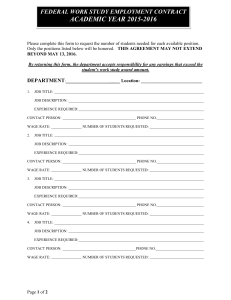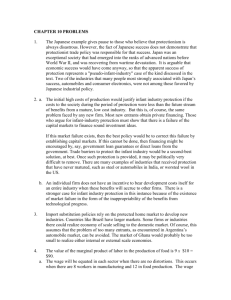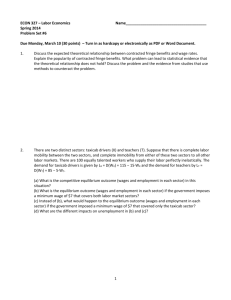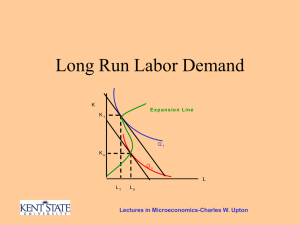Annual Wage Review 2015 Submissions
advertisement
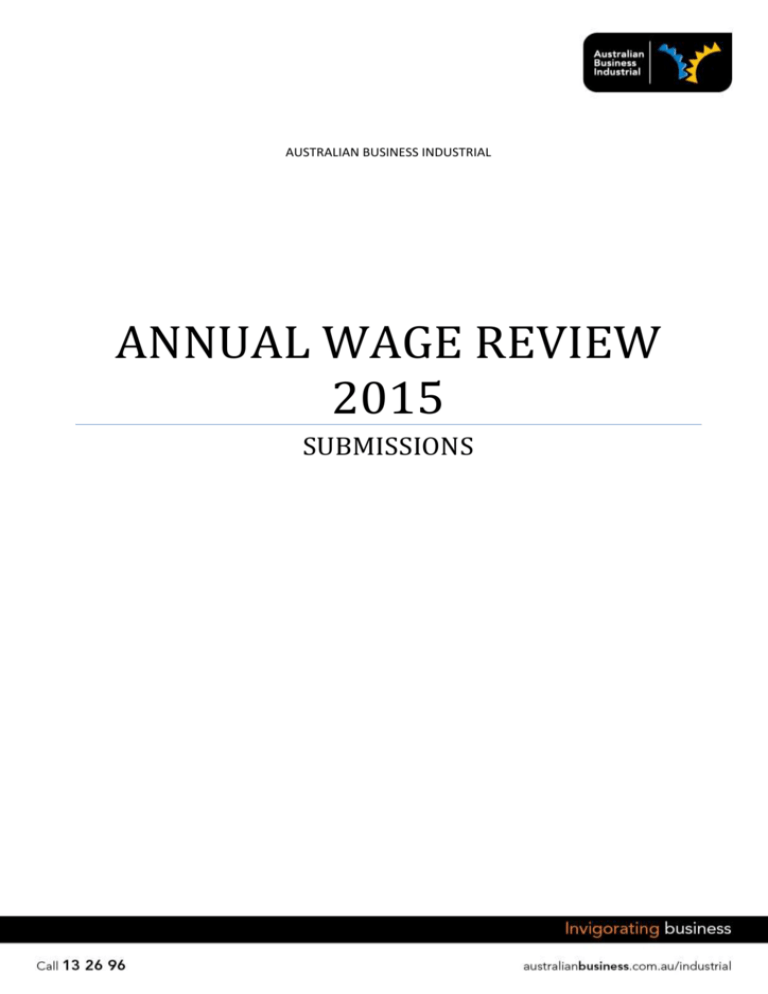
AUSTRALIAN BUSINESS INDUSTRIAL ANNUAL WAGE REVIEW 2015 SUBMISSIONS 1 Executive Summary These are the submissions of Australian Business Industrial (ABI) and they are supported by the New South Wales Business Chamber Ltd. ABI recommends that the Panel adopt a cautious approach and confine itself to a modest sustainable increase that is significantly lower than the amounts that have been awarded in previous years, recognising that economic conditions in Australia have continued to deteriorate. The evidence suggests that increases determined in previous annual wage reviews may not have been as sustainable as thought at the time. About ABI and the NSW Business Chamber Ltd ABI is registered under the Fair Work (Registered Organisations) Act 2009 and has some 4,200 members and NSWBC Ltd is a recognised State registered association pursuant to Schedule 2 of the Fair Work (Registered Organisations) Act 2009 and has some 18,000 members. NSWBC Ltd is registered under the (NSW) Industrial Relations Act 1996. ABI comprises those NSWBC Ltd members who specifically seek membership of a federally registered organisation. Contact: Tim Hicks Policy Adviser Business Regulations and Economics, NSW Business Chamber Limited Tim.Hicks@nswbc.com.au +612 9458 7259 Dick Grozier Director of Industrial Relations, Australian Business Industrial Dick.grozier@nswbc.com.au +612 9458 7574 2 Introduction Under the Fair Work Act 2009 (FW Act) the FWC must undertake an annual wage review each financial year, and must be constituted by an expert panel (Panel) when it does so. The Panel has as its statutory function the review of modern award minimum wages, which may or may not lead to their variation, and the national minimum wage order (NMWO). The review must give rise to a new NMWO, and the Panel must take account of the rate of the national minimum wage (NMW) it is setting in the NMWO in determining modern award minimum wages. The Panel is required to comply with the minimum wages objective, the modern awards objective and the objects of the FW Act which collectively provide a diversity of matters which are to be taken into account in the annual wage review. These broadly fall under social, economic and factors associated with the need to encourage collective bargaining. The Panel has discussed this framework in its previous decisions and most recently has again stated that it does not adopt a “mechanistic” approach when striking that balance. “As the Panel has observed before, there is often a degree of tension between the economic, social and other considerations which the Panel must take into account. It is this complexity which has led the Panel to consistently reject a mechanistic or decision rule approach to wage fixation, such as the adoption of real wage maintenance.”1 “It is important to appreciate that there is often a degree of tension between the economic, social and other considerations which the Panel must take into account. For example, a substantial wage increase may better address the needs of the low paid and improve the relative living standards of award-reliant employees, but it may (depending upon the prevailing economic circumstances) also reduce the capacity to employ the marginalised and hence reduce social cohesion. It is this complexity that has led the Panel to reject a mechanistic or decision rule approach to wage fixation, such as the adoption of real wage maintenance. The real wages of award-reliant employees are relevant to our task, but not determinative. The range of considerations we are required to take into account calls for the exercise of broad judgment rather than a mechanistic approach to fixing minimum wages.” 2 The Panel has also commented on the fact that submitting parties tend to focus on those matters which are required to be taken into account which they regard as important or of assistance to the outcome they contend for. “The submissions of the parties focus, naturally enough, on those statutory considerations which support the outcome for which they contend. However, the Act requires the panel to take account of all the relevant statutory considerations and the range of matters we are required to take into account is not limited to economic considerations.”3 Beyond the Panel’s control of course, but this raises a very real question about the AWR process and criteria the Panel is required to balance. Whilst it is true that the matters which the Panel must take into account are not limited to the economic, there comes a time when the state of the labour market and the 1 Para 6, Annual Wage Review 2013-14, [2014] FWCFB 3500 Para 72, Annual Wage Review 2013-14, [2014] FWCFB 3500 3 Para 8, Annual Wage Review 2013-14, [2014] FWCFB 3500 2 3 long term trends at play within it, and employer capacity to pay, must be given greater weight. There is little evidence of a contemporary labour supply problem. Submissions The Panel’s 2013-14 decision In June 2014, Panel determined to increase the national minimum wage (NMW) and modern award wages by 3.0 per cent, which equates to $18.70 per week increase to the NMW. This increase was significantly higher than the 2.6 per cent increase that it awarded in the previous year. Various factors appear to have influenced the Panel’s decision to award the higher increase, although the Panel’s decision4 does not state which factors carried the most weight. These factors include: the Panel’s view that the outlook for the economy was sound; low wage growth in the broader economy and higher labour productivity providing scope for increasing award wages without inflationary consequences; higher inflation, with CPI running at 2.9 per cent in the year to March 2014 compared to 2.5 per cent in the year to March 2013; and the decline in the value of award wages relative to the earnings of other full-time workers. These factors in favour of a higher increase were moderated by the increase the Superannuation Guarantee.5 The fact the Panel has continued to hold the view that modest minimum wage adjustments lead to a small or zero effect on employment was no doubt also influential in its decision.6 ABI’s response to the Panel’s last decision and more recent developments The Panel’s previous decision to award a higher increase on the basis that the outlook for the economy was sound raised the question of how the balance is struck between the various matters which are to be taken into account. In its 2012-13 decision, the Panel responded to submissions that it should take into account downward revisions to forecast conditions by stating that it primarily focused on actual results. In assessing the various economic considerations the Panel takes into account both actual economic indicators and those that are forecast at the time of each decision. Of these, the actual indicators tend to be the primary consideration, because they are by definition more reliable than forecasts. However, it is also appropriate to have regard to future projections that cast some light on the economic circumstances that are expected to apply during the period when any adjustment will operate.7 4 Annual Wage Review 2013-14, [2014] FWCFB 3500 See paras 48-59, Annual Wage Review 2013-14, [2014] FWCFB 3500 6 See para 43, Annual Wage Review 2013-14, [2014] FWCFB 3500 7 See para 7, Annual Wage Review 2012-13, [2013] FWCFB 4000 5 4 This seems a somewhat different emphasis on the weight to be put on existing measures compared to forecast from that in its subsequent decision where the Panel led its 2013-14 decision with a statement that seems predominately focused on the future economic outlook: A number of considerations have led us to award a higher increase than that determined in last year’s 2012–13 Review decision. The economic outlook remains sound, with GDP growth expected to ease in 2014–15 before increasing to just below trend in 2015–16. Employment growth is expected to be stronger in 2014–15, and the unemployment rate is expected to increase only slightly over the forecast period. Inflation has been contained, and is anticipated to slow in the period ahead, approaching the mid-point of the RBA’s target band.8 On one view this statement would seem to describe a situation where the economy’s forecast performance is more positive than its current and immediate past performance, and in this context “sound” carries some ambiguity since it clearly connotes positively but seems to be a euphemistic way of saying less than good. It seems arguable that what should influence the Panel’s decision on whether a consideration favours a higher or lower increase than the previous year is whether the circumstances pertinent to that consideration have worsened or improved. Economic Growth The National Accounts figures for the year to Dec 2012 available to the Panel prior to its 2012-13 decision had GDP growth at 2.9 per cent trend and 3.1 per cent seasonally adjusted. These rates were significantly better than the figures that were available prior to the 2013-14 decision, which marked GDP growth in the year to December 2013 at 2.7 per cent trend and 2.8 per cent seasonally adjusted. The latest growth figures have further deteriorated. The latest National Accounts report GDP growth for the year to December 2014 at just 2.3 per cent trend and 2.5 per cent seasonally adjusted. At some point, GDP growth for the previous years was also drastically revised downwards in comparison to the figures available to the Panel, with trend growth dropping from 2.8 to 2.6 per cent for the year to December 2012 and from 2.7 to 2.4 in the year to December 2013. The State of the Labour Market The story is similar with respect to the state of the labour market at the time of these previous reviews. The Labour Force figures for April 2013 which were available to the Panel prior to its 2012-13 decision marked the unemployment rate at 5.5 per cent on a trend and seasonally adjusted basis. The Labour Force figures for April 2014 that were available prior to the 2013-14 decision marked the unemployment rate at 5.9 per cent trend and 5.8 per cent seasonally adjusted. The latest Labour Force figures are for February 2015 and they mark unemployment at 6.3 per cent on a trend and seasonally adjusted basis. It seems unlikely that there will be any easy turn-around of these figures by then, but the April Labour Force figures will again be available prior to the Panel’s 2014-15 decision issuing. Better Productivity, lower wages Ion its 2013-14 decision the Panel appears to have placed some weight on higher labour productivity and lower private sector wage growth. ABI agrees that it appears possible that labour productivity growth over the current decade will be higher than it was in the previous one. That said, it is also true that labour productivity growth, measured on the basis of market sector gross value added (GVA), has been falling in 8 See para 48, Annual Wage Review 2013-14, [2014] FWCFB 3500 5 recent years, from 3.9 per cent in the year to December 2012 to 1.9 per cent in the year to December 2013 and down to 0.3 per cent in the latest figures for the year to December 2014. Overall labour productivity growth measured on a GDP basis fell from 2012 to 2013, but increased, albeit only slightly, from 2013 to 2014. However, labour productivity is more meaningfully measured for the market sector than for the economy as a whole, because there is no way of accurately measuring the output of industries that are dominated by the public sector. Moreover, it should not be assumed that productivity increases mean an improved capacity for employers to meet higher wage increases and maintain current levels of activity. The reasons for labour productivity growth are also a very important factor. Increases in labour productivity over the last decade have been almost exclusively driven by increases in capital stock, rather than increases in the amount that a worker produced with a given capital stock. Capital, too, is to be paid for. Some of this capital investment does translate into higher wages for workers, but ultimately investors require a competitive rate of return on their investment and if excessive wage increases reduce the local rate of return below internationally competitive levels future investment will fall and long-term living standards will be lower. It is also of note that that recent improvements in labour productivity growth have occurred in the context of a weakening labour market, and much of the improvement in labour productivity may simply be due to the fact that less productive workers are losing jobs and not finding new ones. ABI contends that there are too many variables to determine how productivity changes should translate to wage increases so it is important to give particular attention to the actual changes in wages that have resulted from negotiations between workers and their employees in the private sector. The best available measure for this is the Wage Price Index (WPI) because it takes into account compositional changes that otherwise distort the picture of how wages in given roles are changing. All measures of wage growth are at record lows. In its 2013-14 decision the Panel concluded that this supported a higher wage increase because it indicated that inflationary pressures were contained. This is true, but weak wage growth across the economy with an uncapped bargaining regime is also a clear indication that the capacity of employers to increase wages is at record lows. Inflation ABI agrees that the changes in the rate of inflation between the 2012-13 and 2013-14 decisions supported a higher wage increase if something like real wage maintenance or small real wage increases are in fact the statutory goal. The change in the then available most up to date inflation figures moved from 2.5 per cent to 2.9 per cent. This meant that the minimum increase to provide award-reliant workers with a real wage increase above past inflation moved from 2.6 per cent, which is what the Panel determined in 201213, to 3.0 per cent, which is what the Panel determined in 2013-14. Headline inflation has dropped to just 1.7 per cent in the year to December 2014. Minimum wage increases and employment The Panel has concluded that, on the evidence presented to it to date, a modest increase in minimum wages will have small or even zero employment effects. This is clearly contested territory both because of what is meant by “modest” and also because of the mixed empirical findings. The most recent research in the empirical debate about how to measure minimum wage effects in the US (accepting that its statutory minimum wage structure does not stand as a good proxy for Australia’s) suggests that a 6 number of the prominent studies previously brought to the Panel’s attention may have had serious methodological flaws.9 This debate is still ongoing, but this suggests a more tentative conclusion than the Panel’s current finding until the outcome is better known. It is also important to recall that the higher level of Australia’s national minimum wage and the complexity of the award minimum wage classification system and other features of Australia’s workplace relations regulation mean that the effect of increasing minimum wages in Australia is almost certainly significantly greater than it would be in most if not all external economies. This is certainly true of comparisons with the US economy and the nature of the increases captured in these studies. Even if changes in the minimum wage flow through to areas other than employment, such as profits and prices, they may reduce the wages of minimum wages workers in the long-run by reducing future investment. Even presuming that a “modest” increase would have very limited effects, the amount of increase that could be considered “modest” must be substantially lower than it has been in recent years in light of changes in economic circumstances10. With respect to relative living standards and the needs of award-reliant workers, the Panel is required to take into account changes in actual living standards, not just changes in earnings. On the basis of actual living standards households in the lower income deciles have performed much better than if distribution is only analysed on the basis of earnings. As recognised by the Panel many low income earners are not in the lowest income households and the chief problem for low income households with wage earners lies not with award reliance per se, but with the hours which are available to the employee(s) concerned.11 As they work limited hours, increasing the hourly wage will do little for their living standards and they may even be worse of the if higher hourly wages leads to them working fewer hours and paying higher prices. With this in mind it is pertinent to note that underemployment has been trending up, with trend underemployment reaching 8.7 per cent in February 2015 up from a low of 5.9 per cent in May 2008.12 Award reliance The measurement of award reliance is not easy and also highly dependent on the notion of award reliance which is used. The extent and concentration in award reliance is clearly important for reviewing modern awards because any determination increasing modern award minimum wages has direct impact on those employees and employers. The evidence suggests that the impact of determined increases may go beyond the directly award reliant because of a variety of indirect transmission effects (award-based pay-setting arrangements) but it is difficult to quantify the extent and nature of these.13 It is also therefore difficult to determine the implications of award-based pay-setting arrangements for the various matters which are to be taken into account, such as the impact of a proposed increase on bargaining. 9 See Neumark, David, Jm I. Salas, and William Wascher. “More on Recent Evidence on the Effects of Minimum Wages in the United States.” IZA Journal of Labor Policy 3, no. 1 (December 12, 2014): 24. doi:10.1186/2193-9004-324. 10 Para 43, Annual Wage Review 2012-13, [2013] FWCFB 4000 11 See for example, Measuring Minimum Award Wage Reliance in Australia: the HILDA Survey Experience, Wilkins R and Wooden M, Working Paper 11/11, Melbourne Institute Working Paper Series 12 ABS Cat 6202.0, Labour Force, Australia, February 2015 13 See, for example, P 37, Award Reliance, FWC Research Report 6/2013 7 There are some indirect indicia. Recent ABS figures suggest an increasing incidence of award reliance. In May 2010 15.2 per cent of employees were paid the award rate, compared to 16.1 per cent in May 2012 and 18.8 per cent in the most recent (May 2014) Employee Earnings and Hours (EEH) figures. Over that time the percentage of employees whose wages were set by collective agreement has declined from 43.4 per cent in May 2010 to 41.1 per cent in May 2014. This seems mainly to have been experienced in the private sector. In May 2014 award reliance in the private sector was 21 per cent of employees compared to 18.4 per cent in May 2012. The private sector is not only the most important focus of the annual wage review because of its absolute size (81.2 per cent of employees compared to 80.4 per cent in May 2012)14, but also because only a negligible proportion of private sector employees are not employed by national system employers whereas that is not the case for public sector employees. As well, although small businesses (those with fewer than 20 employees) employed 23.3 per cent of all employees, small business employed 37.9 per cent of employees paid by award only, and these employees received the lowest average weekly total wages for any method of pay and for any employer size category. Small business also employed proportionately more employees under individual arrangements (38.4 per cent) whilst at the same time paying lower average weekly total wages to these employees than to the employees they employed under collective agreements. This was not the case for any other size range of employers, and it was not the case in May 2012 when in common with other employers, small businesses on average paid their employees under individual arrangements more than they did those under collective agreements. Businesses with under 20 employees employed almost a quarter (23.3 per cent) of all employees other than Owner managers of incorporated enterprises, and 58.0 per cent of employees paid at the apprentice or trainee rate. Average weekly total cash earnings was lowest in businesses with under 20 employees […]. Businesses with under 20 employees had the lowest average weekly total cash earnings for employees paid at the adult rate […].15 These data also provide contemporary confirmation of the Annual report’s observation. Small business tends to interact with the Commission the most in relation to unfair dismissal claims made against them, and with general protections and anti‑bullying applications. They are also more likely than larger employers to be directly affected by modern awards, with more employees of small businesses having their conditions set by these awards.16 The May 2014 EEH figures also show that with one exception, accommodation and food services, award reliant industries became more award reliant between 2012 and 2014. 14 Employee Earnings and Hours, May 2014, ABS Cat 6306.0, 22 January 2015 and May 2012, 23 January 2013 Employee Earnings and Hours, May 2014, ABS Cat 6306.0, 22 January 2015 16 P 15, Annual Report 2013-14, Fair Work Commission 15 8 Industry Accommodation and food services Administrative and support services Retail trade Other services Health care and social assistance Rental, hiring and real estate services Arts and recreational services Manufacturing per cent award reliant e’ees 2012 44.8 29.0 25.6 24.6 19.0 20.9 per cent award reliant e’ees 2014 42.8 37.3 28.5 25.1 22.3 22.1 19.7 11.3 22.0 15.7 Not all industries are the same size and not all are equally homogenous, and compositional structure and change within each of the industries will explain some of these changes. Nonetheless, taken in conjunction with the trends outlined above they suggest that the past wage increases may not have been as sustainable as perhaps thought at the time they were determined, and that for many of these industries, particularly for small employers in the industries, market wages and the capacity to bargain are being crowded out by the level of minimum award wages. Making the NMWO and determinations about modern award minimum wages ABI has recommended that any increase to the NMW is cautious and has also submitted that an increase of the magnitude of last year’s 3 per cent increase would not represent a correct balancing of the matters to be taken into account when giving effect to the minimum wages objective, the modern awards objective and the objects of the FW Act. ABI has not submitted for a NMW to be made in the same terms as that currently in the National Minimum Wage Order 2013-14 (PR551832), nor that there should be no variation to modern award minimum wages. It has submitted that any increase to the NMW (“the adopted increase”) is cautious. ABI also submits that when taking into account the rate of the NMW that it proposes to set that the Panel apply the percentage of the adopted increase to modern award minimum wages. Varying modern award minimum wages by the percentage rate of increase to the NMW is consistent with the Panel’s past practice, except in the special circumstances of its first Decision17, and is consistent with its statutory obligations. This has not been challenged. The National Minimum Wage Order The Panel must make a NMWO and this has the effect of substituting for the National Minimum Wage Order 2013-14 (the current Order). The NMWO comprises the NMW to which the adopted increase is applied together with a number of special minimum wages and a casual loading for award/agreement free employees. ABI makes the following proposals for these other components of the 2014-15 NMWO: The casual loading be set at 25 per cent; Rates for employees with a disability whose productivity is not affected (Special National Minimum Wage 1) be set as in the current Order but with the current rate at 6.2(a) increased by the same percentage rate as the adopted increase; 17 Para 337, Annual Wage Review 2009 – 10, [2010] FWAFB 4000 9 Rates for employees with a disability whose productivity is affected (Special National Minimum Wage 2) be set in as in the current Order but that the rate prescribed in cll A.3.2 and A.8.3 (Appendix A to the NMWO) be adjusted in the same way as the minimum amount payable in the Supported Wages System when that new rate becomes available; Rates in the junior rates pay (Special National Minimum Wage 3) be set as in the current Order; Rates for apprentices (Special National Minimum Wage 4) be set in as in the current Order except for cl 9.3 which should be varied as appropriate; Rates for employees under a training arrangement which is not an apprenticeship (Special National Minimum Wage 5) be set as in the current Order. Determinations about modern award minimum wages For the purposes of modern awards ABI makes the following proposals: Classification rates be increased by the same percentage rate as the adopted increase; Each cell of the National Training Wage schedules be increased by the same percentage rate as the adopted increase; The minimum amount payable under Supported Wages System schedules (at cll X.4.2 and X.10.3) be increased to the new amount set as the income test threshold for the Disability Support Pension when that is released in June. There remain some transitional minimum wage instruments which have not been terminated. These remaining transitional minimum wage instruments do not cover employees covered by a modern award and most are associated with the Social, Community and Disability Services Industry Equal Remuneration Order 201218 which applies to employees covered by some streams of the Social, Community, Home Care and Disability Services Award 2010. Other remaining transitional minimum wage instruments apply to their residual coverage outside the coverage of the system of modern awards. ABI proposes that the rates in these transitional minimum rates instruments be increased by the same percentage rate as the adopted increase. Allowances in modern awards The Panel has adopted the practice of issuing drafts of the changes to allowances and draft orders, and providing for comment. This is very helpful to assist consistent understanding of the increases and reducing the likelihood for misunderstandings. ABI both thanks the Commission for undertaking this task and remains a strong supporter of its continuing. 18 PR525485 10

